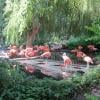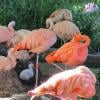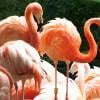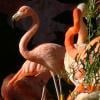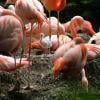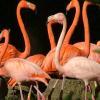The name Flamingo derives from the Latin meaning flame. There are six species of flamingo, three of which are exhibited here at Flamingo Land. These are Greater Flamingo (Phoenicopterus roseus), Caribbean Flamingo (Phoenicopterus ruber) and Chilean Flamingo (Phoenicopterus chilensis). The remaining three are Andean flamingo, James’ flamingo and lesser flamingo. Some species can be found in huge flocks of up to 1 million birds!
These distinctive birds have long legs and hooked bills; their long legs allow them to wade deeper into water than other birds. They feed by holding their beak upside down and filtering the algae and crustaceans out of the water. Flamingos get their pink colouration from the food they eat, such as molluscs and small shrimp-like aquatic invertebrates. These are found in lagoons and/or alkaline lakes with little or no vegetation. The intensity of their pink colouring depends on the species. In captivity, they are fed on a specially prepared diet which helps to stop their pink colouration from fading.ConservationStatus
Least Concerned
Near Threatened
Vulnerable
Endangered
Critically Endangered
Extinct In The Wild

